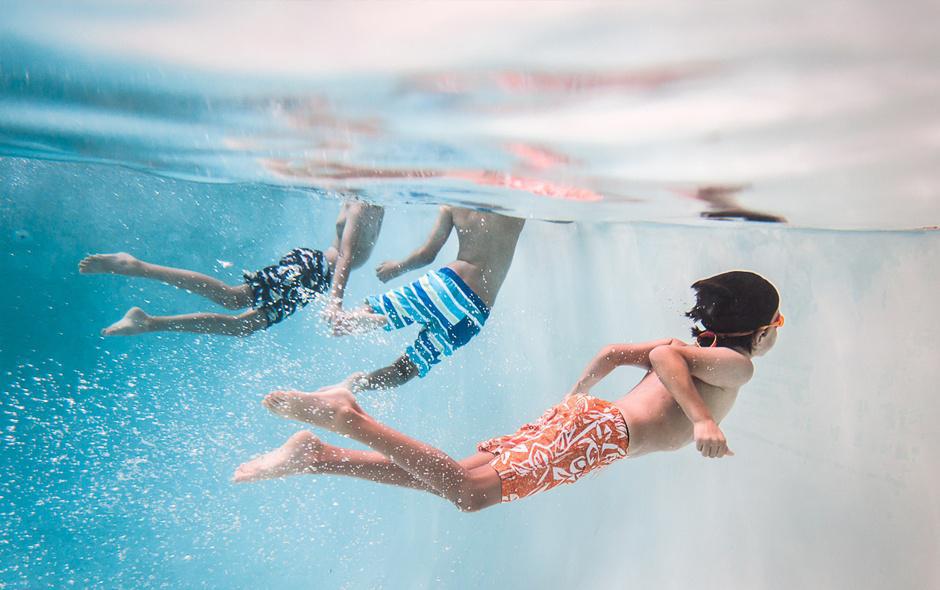

Splashing leads to Success – How Aquatic Therapy can support children with complex needs

Mary McCollum
OTD, OTR/L, Occupational Therapist

What is Aquatic Therapy?
Aquatic therapy is treatment provided by an occupational therapist (OT) or a physical therapist (PT) in an aquatic environment. It is an alternative to land-based services and utilizes an aquatic environment for skilled treatment, and can be used in place of or in combination with traditional therapies. The inherent properties of water are utilized to enhance treatment and provide an environment that is fun, engaging, and motivating when it is being utilized as a therapy medium. Aquatic therapy is designed to develop specific functional skills essential to the performance of land-based tasks.
How does Aquatic Therapy work?
Aquatic therapy, just as OT or PT, begins with an assessment of a child’s skills, abilities, and the family’s concerns. Assessment occurs on land, and is essential to determining if aquatic therapy is beneficial and appropriate for the child as well as if it will support therapy in meeting the family’s goals. Aquatic therapy takes place in a warm-water pool using therapy devices that help in positioning the body and can provide resistance. The child does not need to be able to swim and is not fully submerged during therapy.
What are the benefits of aquatic therapy?
Aquatic therapy uses water as a therapy medium for clients that would benefit from partial weightlessness, or the sensation or pressure of water to achieve land based functional outcomes. Inherent properties of water make it an enhanced media for therapy for kids to work on strength, coordination, and provide opportunities to work on self-care goals. Some of the of the benefits that have been seen include:
- Decreased impact on joints – The buoyancy of water provides support during movement.
- Improved motor planning and coordination – Moving in the water requires coordination of trunk, arms and legs. The increased support from the hydrostatic pressure can aid in balance and decrease the fear of falling.
- Increased postural control and balance reactions – Balance and postural control can be challenged in a safe environment.
- Whole body sensory input – Water provides a kinesthetic environment as it surrounds the submerged individual. This provides proprioceptive and tactile input with movement.
- Promotes relaxation – Hydrostatic pressure provides a constant and consistent squeeze like a compression sock or vest and is calming to many people just as being swaddled can be calming for babies. Constant pressure has been seen to decrease the brain’s system of arousal and therefore can be beneficial for individuals who are tactilely defensive.
- Body/positional awareness – The resistive properties of water (such as hydrostatic pressure) provides information to our body about our own movements through our tactile and proprioceptive system, which can increase body awareness.
- Increased active movement of weakened limbs – Buoyancy helps to decrease the forces of gravity, so that less effort is required to move a limb through the water.
- Strengthening – Buoyancy can also be used to challenge both weak and strong muscles, offering resistance through devices such as webbed resistance gloves or foam weights.
- Fun and engaging environment – Being in the water is fun, and kids enjoy splashing and playing while therapy is occurring.
- Increase range of motion (ROM) – Warm water can relax tight muscles allowing for more movement.
- Reduce spasticity – With muscles relaxed and ROM increased, resistance from the water allows for strengthening, and can provide a great medium for therapists to begin reducing spasticity and utilizing neuroplasticity to ensure positive functional outcomes.
- Increased breath control – The hydrostatic pressure of the water provides resistance for our respiratory system allowing for strengthening while submerged. It can also be fun to blow a toy that floats across the surface of the pool or blow bubbles with a straw that is submerged.
Who can benefit from Aquatic Therapy?
Research has shown that there are many individuals that can benefit from the use of aquatic therapy. Below are some diagnoses that have been shown to benefit:
- Cerebral Palsy 3
- Developmental Delay 4
- Autism 2
- Motor Challenges 1,4,5
- Spasticity 1,4
How can I find out more?
To find out more about aquatic therapy, you can reach out to Mary McCollum at mmccollum@highhopesdubai.com, or call High Hopes in Dubai at +971 04 333 3509.
Sources:
1 Cole, A.J. & Becker, B.E. (Eds.). (2004). Comprehensive Aquatic Therapy. Philadelphia, PA: Elsevier Inc.
2 Darcy S. Vonder Hulls, Lisa K. Walker & Janet M. Powell (2009) Clinicians’ Perceptions of the Benefits of Aquatic Therapy for Young Children with Autism, Physical & Occupational Therapy In Pediatrics,26:1-2, 13-22, DOI: 10.1080/J006v26n01_03
3 Dorval, G., Tetreault, S. & Caron, C. (1996). Impact of Aquatic Programmes on Adolescents with Cerebral Palsy. Occupational therapy international, 3(4) 241-261. https://onlinelibrary.wiley.com/doi/pdf/10.1002/oti.39
4 Kucher, G.; Moore, K. Rodia R. & Moser, C.S. (2015) Aquatic Therapy for Children, Journal of Occupational Therapy, Schools, & Early Intervention, 8(4), 277-291, DOI: 10.1080/19411243.2015.1113104
5 Lai, C.-J., Liu, W.-Y., Yang, T.-F., Chen, C.-L., Wu, C.-Y., & Chan, R.-C. (2015). Pediatric Aquatic Therapy on Motor Function and Enjoyment in Children Diagnosed With Cerebral Palsy of Various Motor Severities. Journal of Child Neurology, 30(2), 200–208. https://doi.org/10.1177/0883073814535491
6 McManus, B. M., Kotelchuck, M. (2007). The Effect of Aquatic Therapy on Functional Mobility of Infants and Toddlers in Early Intervention. Pediatric Physical Therapy, 19(4). 275-282. DOI: 10.1097/PEP.0b013e3181575190


